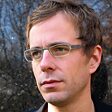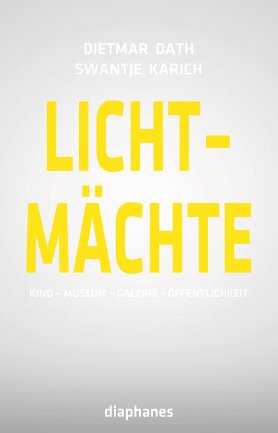Dietmar DathSwantje Karich
Lichtmächte. Kino - Museum - Galerie - Öffentlichkeit
[Light powers. Cinema - Museum - Gallery – Public]
- diaphanes Verlag
- Berlin 2013
- ISBN 978-3-03734-235-0
- 272 Pages
- Publisher’s contact details
Dietmar Dath
Swantje Karich
Lichtmächte. Kino - Museum - Galerie - Öffentlichkeit
[Light powers. Cinema - Museum - Gallery – Public]
This book was showcased during the special focus on Russian (2012 - 2014).
Sample translations
Review
Dietmar Dath is a writer and theater critic for the Frankfurter Allgemeine Zeitung, Swantje Karich is an art critic at the FAZ as well. They both teach at universities, and now they have co-authored a book (working jointly and alone) with the somewhat cryptic title, “Light powers: Cinema - Museum - Gallery – Public.” What is a light power?
According to the authors, it is “a metaphor,” with a long list of terms in tow: “Light which stands for presence, real-time, suggestion, phantom character, symbolism. Power, which stands for influence, coercion, subjugation, creating a loyal following, seduction.” Putting it mildly, that sounds like a rather heterogeneous group of topics. The book’s structure is so open that a number of themes are dealt with from a variety of perspectives. The authors themselves claim that the book should be seen more as a travel guide than as a map, the documentation of a process rather than a bird's eye view. That it produces such a wealth of connections can hardly be considered a drawback.
First of all, this 270-page collection of essays focuses on the places, and non- places, of aesthetic and artistic representation. It follows the occasionally sharp-edged, occasionally subliminal cracks in the always dynamically moving tectonics of media and data storage. Dietmar Dath shows us how the DVD has transformed television into a, “flexible movie theater,” thus unleashing a similar revolution as when “talkies” took over the silent screen. Flexible movie theater: that means not only that the DVD is similar to the book, in the sense that you can turn the page, but that you can effortlessly press the fast forward and fast backward button. It also offers a clue to how this new medium has altered our social behavior.
Home entertainment, which is available everywhere and at all times, forced the movie theater to come up with something entirely new if it wanted to remain competitive: The multiplex giants were only able to survive through the 3D spectacle and by celebrating place and technology, they created a completely new event culture that has more to do with the museum than the well-trodden trip to the art house cinema.
We can observe especially in 3D movie theaters how seduction works (a constant agent in the inventory of power) in terms of an overwhelmed audience entranced by the stereoscopic imagery. But this is not an imposition for the head, it is for the belly. And, therefore, a very different type of experience is inflicted upon audiences than when they encounter film and art (put simply: Video Art) in museums and galleries. The question is, according to Swantje Karich: “What does art expect from film, what does film expect from art, and what do they both expect from each (or both) audiences?”
Karich offers two possibilities: either one medium acquiesces to the other in terms of simply adding one to the other, or, and possibly better, they multiply and mutually reinforce each other. Ultimately, the authors proclaim in a French-Situationist-manifesto-like-tone, the entangled light powers will create something new. They will become “imaginary institutions through which ideas of freedom can be achieved through a socially induced self-determination.” This freedom no longer will have its roots in political idealism, but rather through the concrete reception of free-floating arts. Dietmar Dath asks in the end, “What is the opposite of dreams? This opposite of dreams is called playing.”

According to the authors, it is “a metaphor,” with a long list of terms in tow: “Light which stands for presence, real-time, suggestion, phantom character, symbolism. Power, which stands for influence, coercion, subjugation, creating a loyal following, seduction.” Putting it mildly, that sounds like a rather heterogeneous group of topics. The book’s structure is so open that a number of themes are dealt with from a variety of perspectives. The authors themselves claim that the book should be seen more as a travel guide than as a map, the documentation of a process rather than a bird's eye view. That it produces such a wealth of connections can hardly be considered a drawback.
First of all, this 270-page collection of essays focuses on the places, and non- places, of aesthetic and artistic representation. It follows the occasionally sharp-edged, occasionally subliminal cracks in the always dynamically moving tectonics of media and data storage. Dietmar Dath shows us how the DVD has transformed television into a, “flexible movie theater,” thus unleashing a similar revolution as when “talkies” took over the silent screen. Flexible movie theater: that means not only that the DVD is similar to the book, in the sense that you can turn the page, but that you can effortlessly press the fast forward and fast backward button. It also offers a clue to how this new medium has altered our social behavior.
Home entertainment, which is available everywhere and at all times, forced the movie theater to come up with something entirely new if it wanted to remain competitive: The multiplex giants were only able to survive through the 3D spectacle and by celebrating place and technology, they created a completely new event culture that has more to do with the museum than the well-trodden trip to the art house cinema.
We can observe especially in 3D movie theaters how seduction works (a constant agent in the inventory of power) in terms of an overwhelmed audience entranced by the stereoscopic imagery. But this is not an imposition for the head, it is for the belly. And, therefore, a very different type of experience is inflicted upon audiences than when they encounter film and art (put simply: Video Art) in museums and galleries. The question is, according to Swantje Karich: “What does art expect from film, what does film expect from art, and what do they both expect from each (or both) audiences?”
Karich offers two possibilities: either one medium acquiesces to the other in terms of simply adding one to the other, or, and possibly better, they multiply and mutually reinforce each other. Ultimately, the authors proclaim in a French-Situationist-manifesto-like-tone, the entangled light powers will create something new. They will become “imaginary institutions through which ideas of freedom can be achieved through a socially induced self-determination.” This freedom no longer will have its roots in political idealism, but rather through the concrete reception of free-floating arts. Dietmar Dath asks in the end, “What is the opposite of dreams? This opposite of dreams is called playing.”
Translated by Zaia Alexander

By Ronald Düker
Ronald Düker is a cultural scientist and author for the feature section of the newspaper DIE ZEIT. He lives in Berlin.
